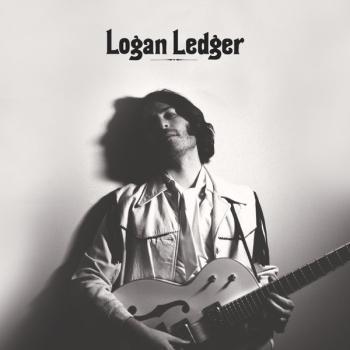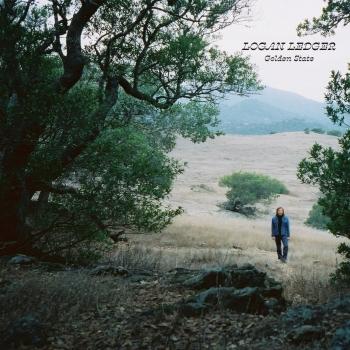Logan Ledger
Biography Logan Ledger
Logan Ledger
Bay Area-bred singer/songwriter Logan Ledger sets most of his songs in lightless or shadowy spaces: the bottom of the ocean, the abandoned cells of Alcatraz, dreamless bedrooms, desolate streets in the dead of night. Produced by 13-time Grammy Award-winner T Bone Burnett, the Nashville-based artist’s self-titled debut matches his moody noir lyricism with a darkly toned take on country music, a sound that’s stylistically wayward yet deeply grounded in classic songmanship.
With Burnett playing guitar on more than half the tracks, the album finds Ledger backed by guitarist Marc Ribot (Tom Waits, Elvis Costello), drummer Jay Bellerose (Willie Nelson, Jackson Browne), and bassist Dennis Crouch (Loretta Lynn, Dolly Parton)—the same band that played on Raising Sand by Robert Plant and Alison Krauss, a Burnett-produced release that won Album of the Year at the 2009 Grammy Awards. Joined by guitarist/pedal steel player Russell Pahl (Kacey Musgraves, Tyler Childers), the band artfully threads in elements of acid rock and surf music and baroque ’60s pop to forge a decidedly Californian sound. But as the sonic antithesis of the sunshiney folk that Jimi Hendrix called “Western sky music,” the album is nearly subterranean in its mystique, indelibly informed by what Ledger refers to as “that gloomy, nocturnal, San Francisco/Ocean Beach vibe.”
Recorded at House of Blues Studios in Nashville, Logan Ledger emerges as a distinctly electric offering, yet continually reveals the rootsy sensibilities at the heart of his kinship with Burnett. “I think we’re each attracted to the more sinister aspects of folk and roots music, and we each have a desire to keep that music alive while finding a way to make something new out of it,” Ledger says. In turn, the album bears an era-defying quality made all the more powerful by Ledger’s voice, a timeless instrument that channels utter lonesomeness even in the album’s most joyous moments.
Right from its first seconds, Logan Ledger proves to be blessedly removed from all musical convention. To that end, opening track “Let The Mermaids Flirt With Me” arrives as a gorgeously languid lullaby, its narrator longingly daydreaming his own death. A downhearted mood imbues much of the album, including “Invisible Blue” (a woozy meditation on inescapable sadness) and “Tell Me A Lie” (a sublimely tragic ballad written with John Paul White, formerly of The Civil Wars). And on “Nobody Knows,” Ledger achieves a cinematic grandeur, the drama intensified by his haunting lyrics (“Nobody knows where the lonely go/Nobody really seems to mind”).
Though Ledger sustains a certain heavy-heartedness even on the album’s uptempo tracks, that element is beautifully offset by the palpable joy behind each performance. On “Starlight”—a lovesick paean to self-delusion, its lyrics suffused in the minimalism of hillbilly haiku—the band slips into a prolonged instrumental section almost trance-like in effect. “We were jamming and once the song was finished, we just played the whole thing again,” Ledger recalls. “It was totally spontaneous and felt really good, so we kept it.” Two songs later, Ledger takes a cue from all those swoony Roy Orbison songs about dreaming, then flips the script with the oddly glorious “I Don’t Dream Anymore.” “It could be taken quite literally—the way I’m living, I don’t remember my dreams at all these days—or it could reflect a cynical attitude toward modern times,” Ledger notes.
Written by Burnett, “(I’m Gonna Get Over This) Some Day” brings a more cheerfully gritty pragmatism to the current moment. “It reminds me of something Johnny Cash would’ve recorded, where he’s addressing a serious matter in a very lighthearted way,” says Ledger. “In this case it’s forgiveness, and T Bone put a political lens on it: it’s about forgiving people who think differently from you, and trying to find some common ground.” The only other track on the album not authored by Ledger, “Skip a Rope” offers a playful yet potent update of Henson Cargill’s 1967 single—a No. 1 hit on the country charts, spiked with still-pertinent social commentary (“Never mind the rules, just play to win/And hate your neighbor for the shade of his skin”). “It’s sad that a song recorded so long ago is just as relevant now, but I think it’s important to show that there’s a progressive side to traditional music, and that we shouldn’t ever lose that,” says Ledger.
Elsewhere on the album, Ledger embeds his songs with strangely mesmeric storytelling. Co-written with Steve Earle, “The Lights of San Francisco” is a softly swaying lament narrated by a ghost wandering Alcatraz Island, eternally taken with the city lights. On the wildly hypnotic “Electric Fantasy,” he delivers a truly singular marvel of imagination: a psychedelic surf song built on endlessly shifting time signatures, its lyrics mining inspiration from Ziggy Stardust-era David Bowie and relaying the story of a romantically frustrated computer program (“I want to hold you tight/My cathode ray/Will keep us warm at night”). And on the exquisitely melancholy “Imagining Raindrops,” Ledger takes a wholly mundane experience (“There was a day when I thought it was raining outside, but it wasn’t,” he explains) and twists it into a lyrical metaphor that feels both forlorn and defiant: “The world I see I don’t believe.”
All throughout his debut, Ledger makes abundant use of his self-described “archaeological impulse with regards to music-making.” “I’ve always believed that in order to create something new with purpose, one must be steeped in the past and work from within the tradition,” he says. “It has more gravity that way.” Ledger’s self-guided musical education began back in the Bay Area, where he first felt drawn to sing after his grandmother introduced him to the music of Elvis Presley, Roy Orbison, and R&B vocal groups like The Platters. Taking up guitar at age 12, he soon began writing songs of his own, along with amassing a huge collection of Smithsonian Folkways CDs and immersing himself in the music of country/blues artists like Doc Watson and Mississippi John Hurt. While attending Columbia University, he hosted a bluegrass show on the campus radio station and played in a number of bluegrass bands, then headed to San Francisco after graduation.
In 2013, after a year and a half back in the Bay Area, Ledger moved to Nashville on a whim. Although his early days in the city were mostly spent working in bars and playing in cover bands, he later crossed paths with guitarist Mark Thornton and ended up recording a demo of “Let The Mermaids Flirt With Me” in Thornton’s home studio. Soon enough, that demo landed in the hands of Dennis Crouch, who then passed it on to Burnett. After he’d shared a few more demos with the legendary producer, Burnett invited Ledger to his home in Los Angeles.
Since teaming up with Burnett, Ledger has joined him onstage in the only two full-band performances Burnett’s done in recent years. And on Ledger’s album, the duo’s immediate chemistry extends to a charmed communion between all of the featured musicians. “So much of this record is people not playing clearly defined rhythmic or lead roles—we’re all sort of twirling around each other and creating this great big texture of sound together,” says Ledger. “A typical country record would have very clearly defined solos, but I’m not interested in that. I love how everyone’s constantly improvising, but without ever getting in anybody else’s way.”
For Ledger, that uninterrupted and possibly transcendent flow is also the desired takeaway for listeners of his debut album. “I’d love for people to get into a meditative space when they hear the record, to sit with the songs and really take their time with them,” he says. “I think there’s a value in letting things happen at a much slower pace, especially in our current culture of instant gratification. It’s really not even a conscious decision for me—it’s just how I feel and how I like to do things, so I’m just going to keep going with it.”












